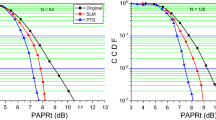Abstract
In code division multiple access (CDMA), two or more chips are grouped together to form symbols and each symbol is transmitted during the symbol period. The phase shift keying (PSK) modulation techniques map the digital baseband data into two or more possible signals by varying the phase of a radio frequency (RF) carrier. The recently proposed PSK scheme called ternary PSK (TPSK) scheme can convey three possible symbols. In this paper, a novel ternary based CDMA sequence so-called large area synchronous even ternary (LAS-ET) sequence is introduced to increase spectrum efficiency in TPSK scheme. Its sequence duty ratio and cross-correlation are analyzed. The performance analysis of this sequence is compared with the large area synchronous (LAS) sequence in term of symbol error rate and chip error rate (CER) over various channel models. It is shown that TPSK scheme in LAS-ET sequence outperforms LAS sequence in terms of CER evaluation. At the same time, the spectrum efficiency is doubled when a pair of chips in LAS-ET sequence is mapped into one symbol.
Similar content being viewed by others
References
Haykin S. (2001) Communication systems, 4th ed. Wiley, New York
Adachi F. (1999) BER analysis of 2PSK, 4PSK, and 16QAM with decision feedback channel estimation in frequency-selective slow Rayleigh fading. IEEE Transactions on Vehicular Technology 48(5): 1563–1572
Li, D. (1999). A high spectrum efficient multiple access code. Fifth Asia-Pacific Conference on Communications and Fourth Optoelectronics and Communications Conference (APCC/OECC ‘99) Proceedings 1 (pp. 598–605). 18–22 Oct.
Li D. (2003) The perspectives of large area synchronous CDMA technology for the fourth-generation mobile radio. IEEE Communications Magazine 41(3): 114–118
Wei H., Hanzo L. (2006) On the uplink performance of LAS-CDMA. IEEE Transactions on Wireless Communications 5(5): 1187–1196
Nakamura, M., & Torii, H. (2002). Ternary phase shift keying and its performance. The 5th International Symposium on Wireless Personal Multimedia Communications 3 (pp. 1284–1288).
Xie S., Rahardja S. (2005) Performance evaluation for quaternary DS-SSMA communications with complex signature sequences over Rayleigh-fading channels. IEEE Transactions on Wireless Communications 4(1): 266–277
Goldsmith A. (2005) Wireless communications. Cambridge University Press, Cambridge
Ziemer R. E., Peterson R. L. (1992) Introduction to digital communication. Macmillan Publishing Company, New York
Proakis J. G. (2001) Digital Communications, 4th ed. McGraw-Hill, New York
Choi, B.J., & Hanzo, L. (2002) On the design of LAS spreading codes. IEEE 56th Vehicular Technology Conference (VTC 2002-Fall) Proceedings 4, (pp. 2172–2176), 24–28 Sept.
Rappaport T. S. (2002) Wireless comminications, principles and practice, 2nd ed. Prentice Hall Inc, Upper Saddle River




